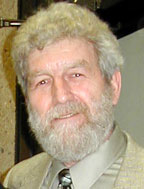 WTO protests rock
Seattle
Mass citizen mobilization
WTO protests rock
Seattle
Mass citizen mobilization
holds lessons for us
By Chuck Armsbury, Senior Editor
 The l999 summit meeting
of the ultimate capitalist club, The World Trade Organization
(WTO), collapsed in the presence of mass protests at the Seattle,
Washington gathering in late November. As many as 75,000 people
arrived from around the world to protest WTO's negotiations in
Seattle. The l999 summit meeting
of the ultimate capitalist club, The World Trade Organization
(WTO), collapsed in the presence of mass protests at the Seattle,
Washington gathering in late November. As many as 75,000 people
arrived from around the world to protest WTO's negotiations in
Seattle.
Protesters contended that full implementation of WTO objectives
for protecting corporate profits would in time nullify national
laws regulating the environment, reverse organized labor's gains
from a century's struggle, and smash accepted standards of human
rights and dignity embraced by international law in this bloodiest
of centuries.
In short, WTO goals and objectives became known to millions
of people around the world, and tens of thousands of those millions
came to Seattle shouting "No to the WTO!" Bear in mind,
these thousands of diverse people converged on Seattle to successfully
demonstrate human solidarity and the power of ordinary people
moving together in large numbers.
A Seattle author mentioned in a Spokane newspaper, Paul Loeb,
reported wading through "throngs of protesters and recognized
cashiers from his neighborhood grocery store, local carpenters
and airline pilots chanting among the crowds."
E-mail conversations with people around the country told us
something quite different than the live and literal blow by blow
we were viewing on regional news stations here in the Pacific
Northwest. Only a few national news stories told the nation that
the "Battle of Seattle" is a strong sign that Americans
of all backgrounds are once again ready to confront their government
as we did in the l960s. Media managers also did not say that
police went berserk on many nonviolent protesters and uninvolved
Seattle neighborhood residents.
The Chicago police rioted and smashed heads in l968. The Seattle
robo-cops clubbed and gassed the Constitution in l999, and along
with it, peaceful citizens who simply wanted to exercise their
right to free speech and assembly.
Massive, well-organized marches and gatherings near Seattle's
Space Needle were met with police violence seldom seen in the
United States since the l960s. Television stations filmed scenes
of unidentifiable, helmeted, visored, stutter-stepping 'storm
troopers' in formation, rapping their riot sticks on the pavement.
Lurid scene followed lurid, bizarre scene. A police jackboot
on the head of one protestor was particularly shocking, as was
film of a police officer chasing two female protestors trying
to escape the tear gas. While only a couple of feet away, he
shot the women in the buttocks with rubber bullets. A WTO representative
falling to the pavement pulled out a gun as he rose. Tear gas
everywhere, hundreds of arrests, protesters retreating as police
advanced, protesters advancing where police fell back. A black
Seattle councilman trying to join a meeting in the WTO conference
area was pulled from his car and roughed up by police.
When the clouds of gas cleared, King County Jail was full
of arrestees. The police eventually controlled themselves at
a distance, and the lessons of the Battle of Seattle began coming
in. Following are summarizing highlights of one week of massive,
definite, democratic action in a major world city.
"The protesters managed to put squarely on the agenda
the question of labor rights and environmental rights in a way
that it can no longer be ignored by the American government,"
said Nelson Lichtenstein, a social historian at the University
of Virginia.
Learning to gather in nonviolent solidarity with others is
our first lesson. The huge size and passion of WTO protesters
communicated to the world that people are on the move, voting
with their feet and not afraid to act. The practical value of
democratic principles and tactics was made clearbusiness
as usual won't happen if enough people mean to put labor, environmental
and human rights' issues on the negotiating table alongside trade
issues.
Viewers of Pacific Northwest television film were struck by
the diversity among protesters, and not just racial diversity
alone. Striking steelworkers linked arms with dreadlocked environmentalists,
and a large number of people were women, Asians and youth.
Our membership in The November Coalition is racially and ethnically
diverse. With over 22,000 names on our mailing list we are also
prepared to consider alliances with other grassroots' groups
seeking justice for prisoners and their loved ones. We are coalition
builders.
WTO protesters told the world that profit is not the highest
human value. "People before profits," chanted many
voices. Coalition members can surely link up to this slogan while
considering the profiteering objectives of the Corrections Corporation
of America or the profitmaking policies of federal prison industries.
Finally, the mayhem caused by a minority of protesters put
a spotlight on the mass demonstration. The window-smashing by
a few amplified the attention given to messages of the nonviolent
majority. However, a few unruly anarchists did not fail to deflect
or hide the depth of honesty, concern and determination found
in most of the people interviewed by reporters on the scene.
It is our hope that the year 2000 will be a watershed for
The November Coalition and similar organizations opposing the
rapid prisonification of our country. Mass demonstrations of
human solidarity witnessed in Seattle hold out real hope for
each and every ordinary person organizing to end the Drug War
and bring our loved ones home.

|



